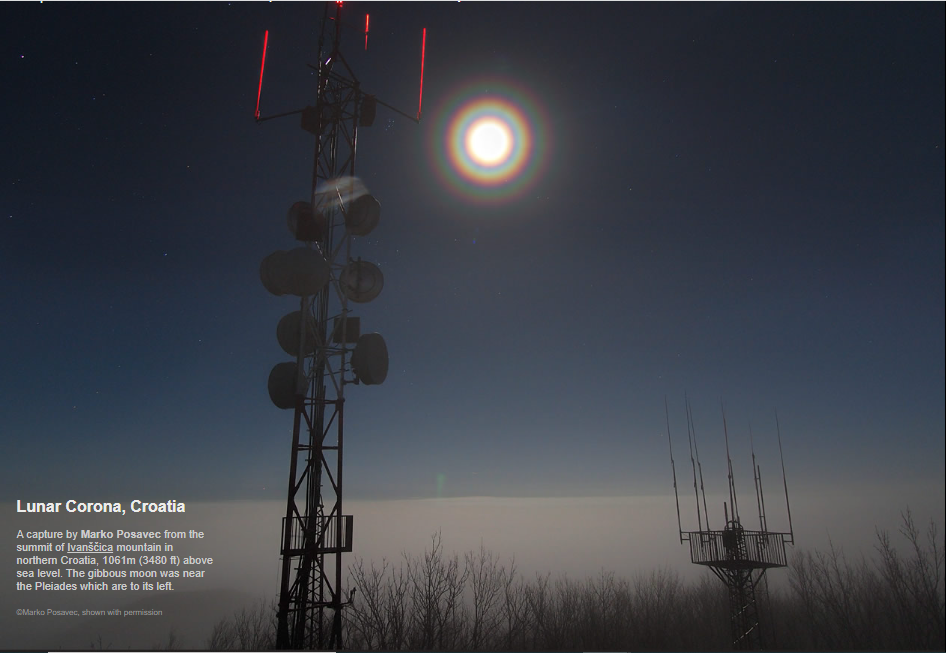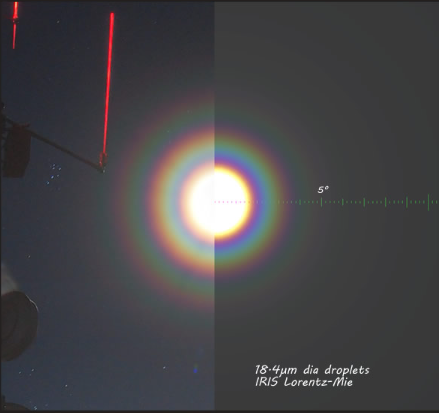Lunar corona, Croatia - OPOD
Lunar Corona, Croatia - A Spectacular Atmospheric Phenomenon
Lunar corona is a captivating atmospheric optics phenomenon that occurs when light from the Moon is diffracted by water droplets in the atmosphere. Recently, a stunning lunar corona was captured by Marko Posavec from the summit of Ivanščica mountain in northern Croatia. Standing at an impressive elevation of 1061 meters (3480 feet) above sea level, Posavec was able to witness this awe-inspiring display of nature.
The conditions that led to the formation of the lunar corona in Croatia were unique. The region had been experiencing a high-pressure system for several days, which caused temperature inversion and resulted in a fog layer covering the lowlands. However, on the mountain summit, the sky remained clear until nightfall when thin wisps of fog, composed of minuscule water droplets, started drifting over the peak.
As these wisps of fog passed over the summit, a brilliant corona with multiple rings appeared around the gibbous Moon. Marko Posavec describes the experience as nothing short of spectacular, with the corona leaving him in disbelief. Unfortunately, the fog eventually obscured the entire scene, but not before Posavec managed to capture the beauty of the moment with his camera.
The formation of a lunar corona is a result of light scattering by water droplets in the atmosphere. When light encounters these droplets, it scatters in all directions. Backward scattering creates a phenomenon known as a glory, which appears opposite the position of the light source, such as the Sun or Moon. Waves scattered at an angle of approximately 40 degrees from the backward direction produce a fogbow.
In the case of a lunar corona, waves are scattered almost forwards along the direction of the incident light. These waves primarily originate from the periphery of the water droplets. The diffraction pattern of the corona is larger when the droplets are smaller, providing valuable insights into the size of the droplets responsible for its creation.
Analyzing the camera and lens details of Marko Posavec's photograph, it can be estimated that the diameter of the second red ring in the corona is approximately 10 degrees. This information helps in understanding the size of the droplets involved. Furthermore, by comparing the photograph to an IRIS (Mie-Lorentz) simulation, it was determined that the droplet diameter was approximately 18.4 microns.
Fog and cloud droplets typically range in size from 1 to 100 microns in diameter. As fog ages, the average droplet size tends to increase, and the size distribution becomes broader. This evolution in droplet size contributes to the dynamic nature of atmospheric phenomena like lunar coronas.
The captivating lunar corona captured by Marko Posavec serves as a reminder of the wonders that can be observed in the Earth's atmosphere. By understanding the physics behind these phenomena, we gain a deeper appreciation for the beauty and complexity of our natural world. Next time you find yourself gazing at the Moon on a foggy night, keep an eye out for the mesmerizing display of a lunar corona, and let it inspire you to explore and appreciate the atmospheric wonders that surround us.

Lunar Corona, Croatia
A capture by Marko Posavec from the summit of Ivanščica mountain in northern Croatia, 1061m (3480 ft) above sea level. The gibbous moon was near the Pleiades which are to its left.
©Marko Posavec, shown with permission

"We had been stuck under a high pressure area for days, which caused the temperature inversion and the fog layer covering the lowlands.
Up on the mountain, however, the sky was clear until nightfall when thin wisps of fog, probably comprised of very small water droplets, started crossing over the summit.
As they did so, a bright corona with multiple rings appeared around the gibbous Moon. The show was so great I could hardly believe my eyes. It was not long, however, before the fog obscured everything.
Photo details:
Olympus E-5, with Zuiko 11-22 mm lens at 11 mm focal length, 25 seconds exposure, f/5.6, ISO 200. Some lens artifacts are visible due to the brightness of the Moon. The picture doesn't do real justice to the visual show. It was simply spectacular."
Water droplets scatter light in all directions.
Backward scattering gives a glory opposite the sun or moon. Waves scattered ~40° from the backwards direction give a fogbow.
Waves scattered almost forwards along the direction of the incident light are responsible for the corona. These waves come mostly from the droplet periphery.
The corona diffraction pattern is larger the smaller the droplets and hence can give information on the size of droplets that created it.
The camera and lens details at left yield the diameter of the second red ring as about 10°. At right the corona is matched against an IRIS (Mie-Lorentz) simulation with a droplet diameter of ~18.4 micron.
Fog and cloud droplets are 1 to 100 micron dia. As fog ages the average droplet size tends to increase and the size distribution broadens.
Note: this article has been automatically converted from the old site and may not appear as intended. You can find the original article here.
Reference Atmospheric Optics
If you use any of the definitions, information, or data presented on Atmospheric Optics, please copy the link or reference below to properly credit us as the reference source. Thank you!
-
<a href="https://atoptics.co.uk/blog/lunar-corona-croatia-opod/">Lunar corona, Croatia - OPOD</a>
-
"Lunar corona, Croatia - OPOD". Atmospheric Optics. Accessed on November 25, 2024. https://atoptics.co.uk/blog/lunar-corona-croatia-opod/.
-
"Lunar corona, Croatia - OPOD". Atmospheric Optics, https://atoptics.co.uk/blog/lunar-corona-croatia-opod/. Accessed 25 November, 2024
-
Lunar corona, Croatia - OPOD. Atmospheric Optics. Retrieved from https://atoptics.co.uk/blog/lunar-corona-croatia-opod/.